charging RENAULT KANGOO VAN ZERO EMISSION 2012 X61 / 2.G Owners Manual
[x] Cancel search | Manufacturer: RENAULT, Model Year: 2012, Model line: KANGOO VAN ZERO EMISSION, Model: RENAULT KANGOO VAN ZERO EMISSION 2012 X61 / 2.GPages: 220, PDF Size: 4.52 MB
Page 7 of 220
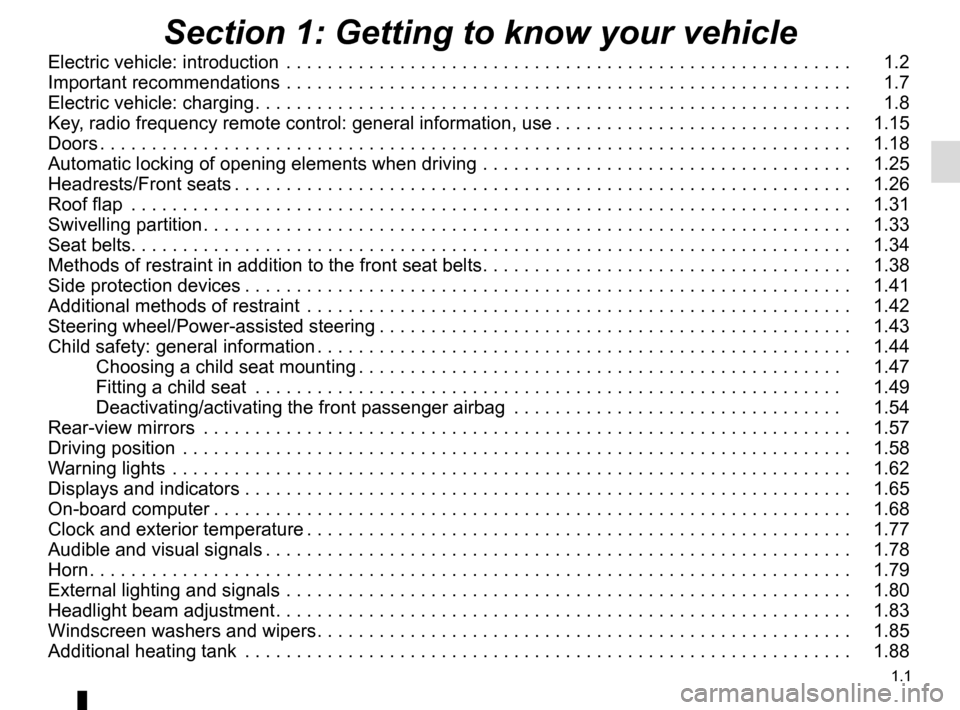
1.1
Section 1: Getting to know your vehicle
Electric vehicle: introduction . . . . . . . . . . . . . . . . . . . . . . . . . . . . . . . . . . . .\
. . . . . . . . . . . . . . . . . . . 1.2
Important recommendations . . . . . . . . . . . . . . . . . . . . . . . . . . . . . . . . . . . .\
. . . . . . . . . . . . . . . . . . . 1.7
Electric vehicle: charging . . . . . . . . . . . . . . . . . . . . . . . . . . . . . . . . . . . . \
. . . . . . . . . . . . . . . . . . . . . . 1.8
Key, radio frequency remote control: general information, use . . . . . . . . . . . . . . . . . . . . . . . . . . . . . 1.15
Doors . . . . . . . . . . . . . . . . . . . . . . . . . . . . . . . . . . . . \
. . . . . . . . . . . . . . . . . . . . . . . . . . . . . . . . . . . . . 1.18
Automatic locking of opening elements when driving . . . . . . . . . . . . . . . . . . . . . . . . . . . . . . . . . . . .\
1.25
Headrests/Front seats . . . . . . . . . . . . . . . . . . . . . . . . . . . . . . . . . . . . \
. . . . . . . . . . . . . . . . . . . . . . . . 1.26
Roof flap . . . . . . . . . . . . . . . . . . . . . . . . . . . . . . . . . . . .\
. . . . . . . . . . . . . . . . . . . . . . . . . . . . . . . . . . 1.31
Swivelling partition . . . . . . . . . . . . . . . . . . . . . . . . . . . . . . . . . . . . \
. . . . . . . . . . . . . . . . . . . . . . . . . . . 1.33
Seat belts. . . . . . . . . . . . . . . . . . . . . . . . . . . . . . . \
. . . . . . . . . . . . . . . . . . . . . . . . . . . . . . . . . . . . . . . 1.34
Methods of restraint in addition to the front seat belts . . . . . . . . . . . . . . . . . . . . . . . . . . . . . . . . . . . . 1.38
Side protection devices . . . . . . . . . . . . . . . . . . . . . . . . . . . . . . . . . . . . \
. . . . . . . . . . . . . . . . . . . . . . . 1.41
Additional methods of restraint . . . . . . . . . . . . . . . . . . . . . . . . . . . . . . . . . . . .\
. . . . . . . . . . . . . . . . . 1.42
Steering wheel/Power-assisted steering . . . . . . . . . . . . . . . . . . . . . . . . . . . . . . . . . . . . \
. . . . . . . . . . 1.43
Child safety: general information . . . . . . . . . . . . . . . . . . . . . . . . . . . . . . . . . . . . \
. . . . . . . . . . . . . . . . 1.44 Choosing a child seat mounting . . . . . . . . . . . . . . . . . . . . . . . . . . . . . . . . . . . . \
. . . . . . . . . . . 1.47
Fitting a child seat . . . . . . . . . . . . . . . . . . . . . . . . . . . . . . . . . . . .\
. . . . . . . . . . . . . . . . . . . . . 1.49
Deactivating/activating the front passenger airbag . . . . . . . . . . . . . . . . . . . . . . . . . . . . . . . . 1.54
Rear-view mirrors . . . . . . . . . . . . . . . . . . . . . . . . . . . . . . . . . . . .\
. . . . . . . . . . . . . . . . . . . . . . . . . . . 1.57
Driving position . . . . . . . . . . . . . . . . . . . . . . . . . . . . . . . . . . . .\
. . . . . . . . . . . . . . . . . . . . . . . . . . . . . 1.58
Warning lights . . . . . . . . . . . . . . . . . . . . . . . . . . . . . . . . . . . .\
. . . . . . . . . . . . . . . . . . . . . . . . . . . . . . 1.62
Displays and indicators . . . . . . . . . . . . . . . . . . . . . . . . \
. . . . . . . . . . . . . . . . . . . . . . . . . . . . . . . . . . . 1.65
On-board computer . . . . . . . . . . . . . . . . . . . . . . . . . . . . . . . . . . . . \
. . . . . . . . . . . . . . . . . . . . . . . . . . 1.68
Clock and exterior temperature . . . . . . . . . . . . . . . . . . . . . . . . . . . . . . . . . . . . \
. . . . . . . . . . . . . . . . . 1.77
Audible and visual signals . . . . . . . . . . . . . . . . . . . . . . . . . . . . . . . . . . . . \
. . . . . . . . . . . . . . . . . . . . . 1.78
Horn . . . . . . . . . . . . . . . . . . . . . . . . . . . . . . . . . . . . \
. . . . . . . . . . . . . . . . . . . . . . . . . . . . . . . . . . . . . . 1.79
External lighting and signals . . . . . . . . . . . . . . . . . . . . . . . . . . . . . . . . . . . .\
. . . . . . . . . . . . . . . . . . . 1.80
Headlight beam adjustment . . . . . . . . . . . . . . . . . . . . . . . . . . . . . . . . . . . . \
. . . . . . . . . . . . . . . . . . . . 1.83
Windscreen washers and wipers . . . . . . . . . . . . . . . . . . . . . . . . . . . . . . . . . . . . \
. . . . . . . . . . . . . . . . 1.85
Additional heating tank . . . . . . . . . . . . . . . . . . . . . . . . . . . . . . . . . . . .\
. . . . . . . . . . . . . . . . . . . . . . . 1.88
Page 8 of 220
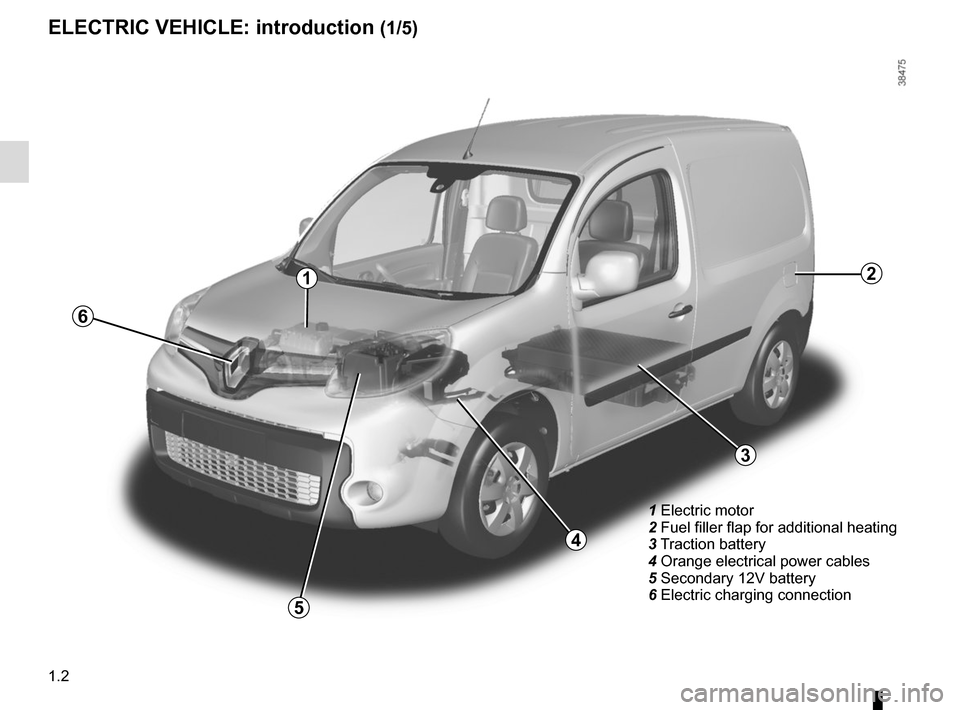
1.2
1 Electric motor
2 Fuel filler flap for additional heating
3 Traction battery
4 Orange electrical power cables
5 Secondary 12V battery
6 Electric charging connection
3
4
5
1
6
ELECTRIC VEHICLE: introduction (1/5)
2
Page 10 of 220
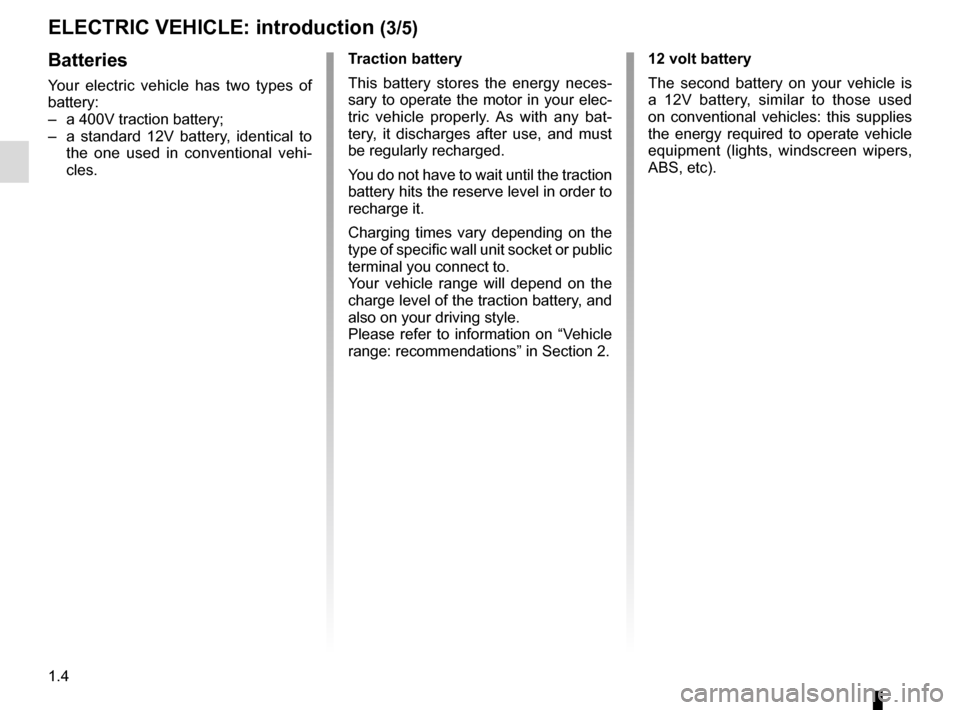
1.4
ELECTRIC VEHICLE: introduction (3/5)
Batteries
Your electric vehicle has two types of
battery:
– a 400V traction battery;
– a standard 12V battery, identical to the one used in conventional vehi-
cles. Traction battery
This battery stores the energy neces-
sary to operate the motor in your elec-
tric vehicle properly. As with any bat-
tery, it discharges after use, and must
be regularly recharged.
You do not have to wait until the traction
battery hits the reserve level in order to
recharge it.
Charging times vary depending on the
type of specific wall unit socket or public
terminal you connect to.
Your vehicle range will depend on the
charge level of the traction battery, and
also on your driving style.
Please refer to information on “Vehicle
range: recommendations” in Section 2. 12 volt battery
The second battery on your vehicle is
a 12V battery, similar to those used
on conventional vehicles: this supplies
the energy required to operate vehicle
equipment (lights, windscreen wipers,
ABS, etc).
Page 12 of 220
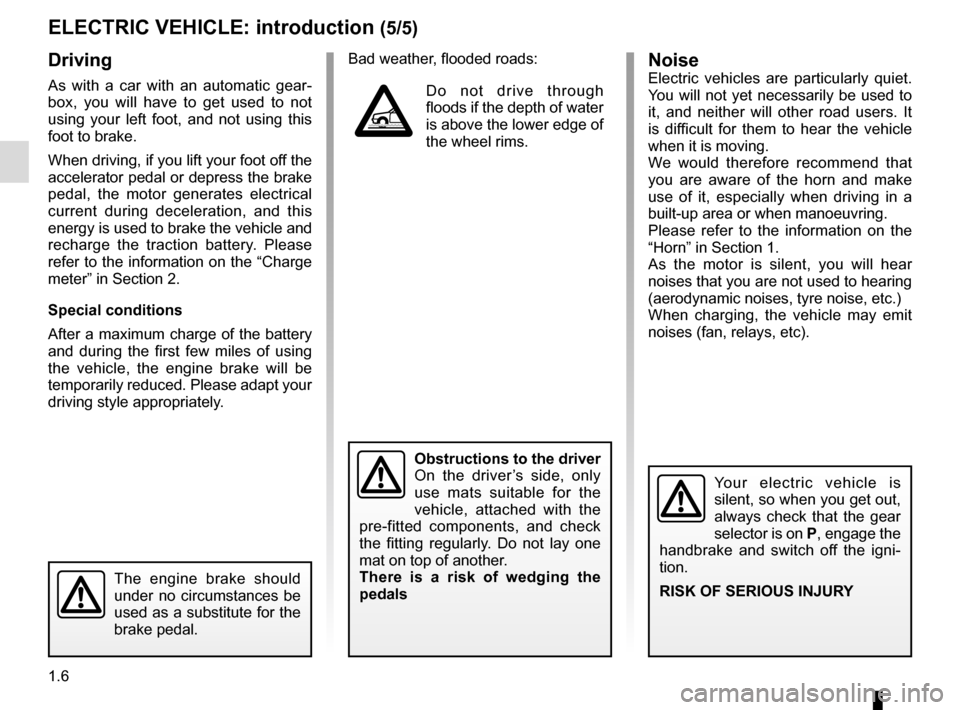
1.6
The engine brake should
under no circumstances be
used as a substitute for the
brake pedal.
NoiseElectric vehicles are particularly quiet.
You will not yet necessarily be used to
it, and neither will other road users. It
is difficult for them to hear the vehicle
when it is moving.
We would therefore recommend that
you are aware of the horn and make
use of it, especially when driving in a
built-up area or when manoeuvring.
Please refer to the information on the
“Horn” in Section 1.
As the motor is silent, you will hear
noises that you are not used to hearing
(aerodynamic noises, tyre noise, etc.)
When charging, the vehicle may emit
noises (fan, relays, etc).
Your electric vehicle is
silent, so when you get out,
always check that the gear
selector is on P, engage the
handbrake and switch off the igni-
tion.
RISK OF SERIOUS INJURY
ELECTRIC VEHICLE: introduction (5/5)
Driving
As with a car with an automatic gear-
box, you will have to get used to not
using your left foot, and not using this
foot to brake.
When driving, if you lift your foot off the
accelerator pedal or depress the brake
pedal, the motor generates electrical
current during deceleration, and this
energy is used to brake the vehicle and
recharge the traction battery. Please
refer to the information on the “Charge
meter” in Section 2.
Special conditions
After a maximum charge of the battery
and during the first few miles of using
the vehicle, the engine brake will be
temporarily reduced. Please adapt your
driving style appropriately. Bad weather, flooded roads:Do not drive through
floods if the depth of water
is above the lower edge of
the wheel rims.
Obstructions to the driver
On the driver’s side, only
use mats suitable for the
vehicle, attached with the
pre-fitted components, and check
the fitting regularly. Do not lay one
mat on top of another.
There is a risk of wedging the
pedals
Page 13 of 220
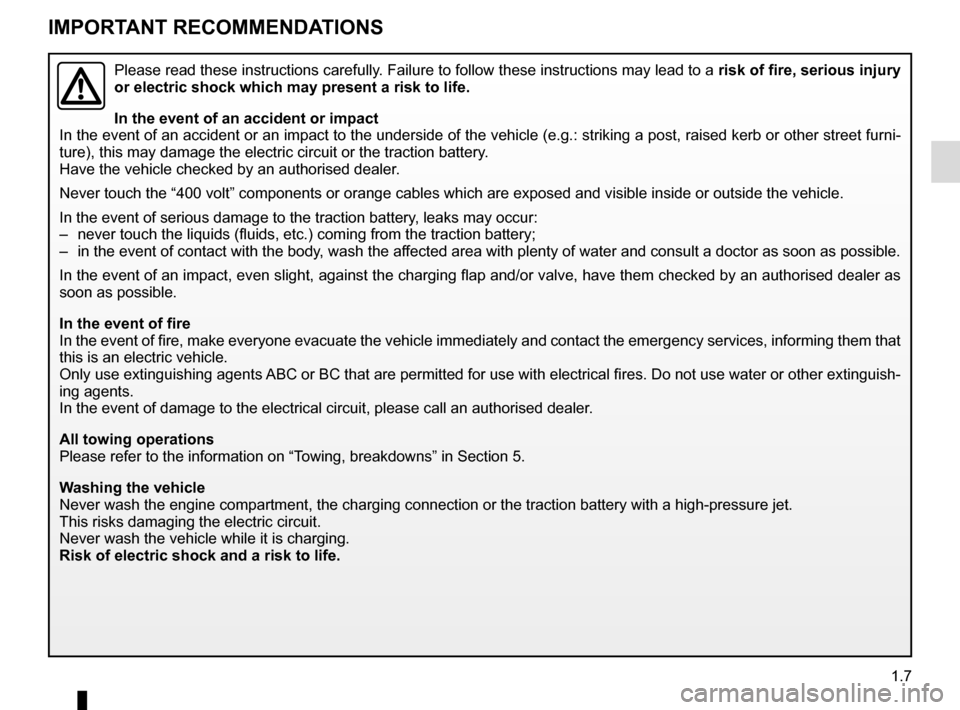
1.7
IMPORTANT RECOMMENDATIONS
Please read these instructions carefully. Failure to follow these instructions may lead to a risk of fire, serious injury
or electric shock which may present a risk to life.
In the event of an accident or impact
In the event of an accident or an impact to the underside of the vehicle\
(e.g.: striking a post, raised kerb or other street fu rni-
ture), this may damage the electric circuit or the traction battery.
Have the vehicle checked by an authorised dealer.
Never touch the “400 volt” components or orange cables which are e\
xposed and visible inside or outside the vehicle.
In the event of serious damage to the traction battery, leaks may occur:
– never touch the liquids (fluids, etc.) coming from the traction batter\
y;
– in the event of contact with the body, wash the affected area with plenty of water and consult a doctor as soon as possibl\
e.
In the event of an impact, even slight, against the charging flap and/or\
valve, have them checked by an authorised dealer as
soon as possible.
In the event of fire
In the event of fire, make everyone evacuate the vehicle immediately and\
contact the emergency services, informing them that
this is an electric vehicle.
Only use extinguishing agents ABC or BC that are permitted for use with electrical fires. Do not use w\
ater or other extinguish-
ing agents.
In the event of damage to the electrical circuit, please call an authori\
sed dealer.
All towing operations
Please refer to the information on “Towing, breakdowns” in Section 5.
Washing the vehicle
Never wash the engine compartment, the charging connection or the tracti\
on battery with a high-pressure jet.
This risks damaging the electric circuit.
Never wash the vehicle while it is charging.
Risk of electric shock and a risk to life.
Page 14 of 220
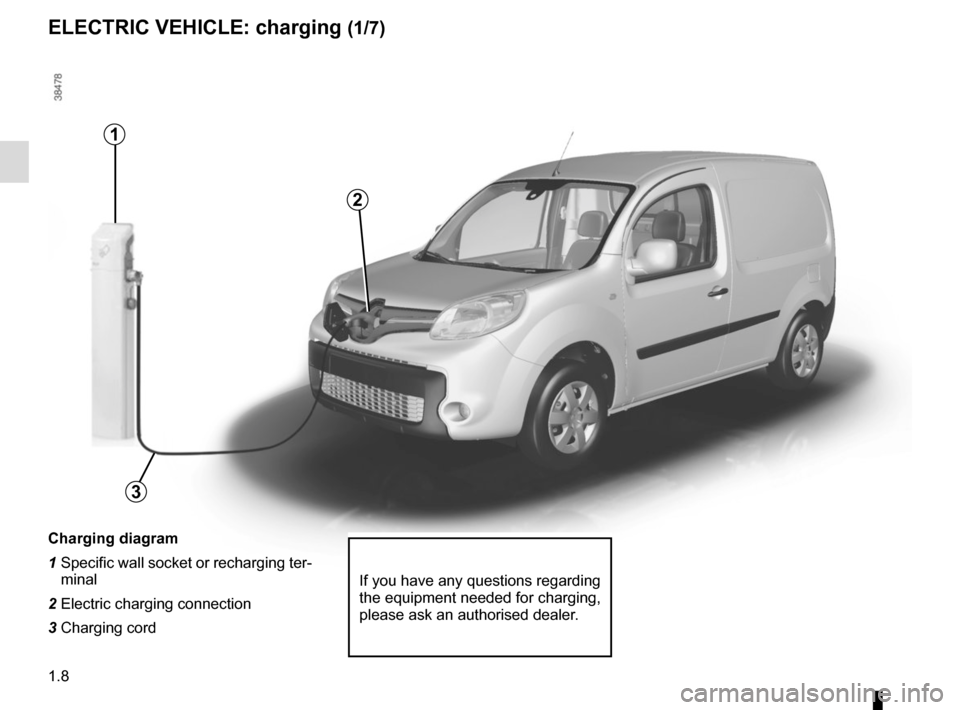
1.8
ELECTRIC VEHICLE: charging (1/7)
Charging diagram
1 Specific wall socket or recharging ter-
minal
2 Electric charging connection
3 Charging cord
If you have any questions regarding
the equipment needed for charging,
please ask an authorised dealer.
1
3
2
Page 15 of 220
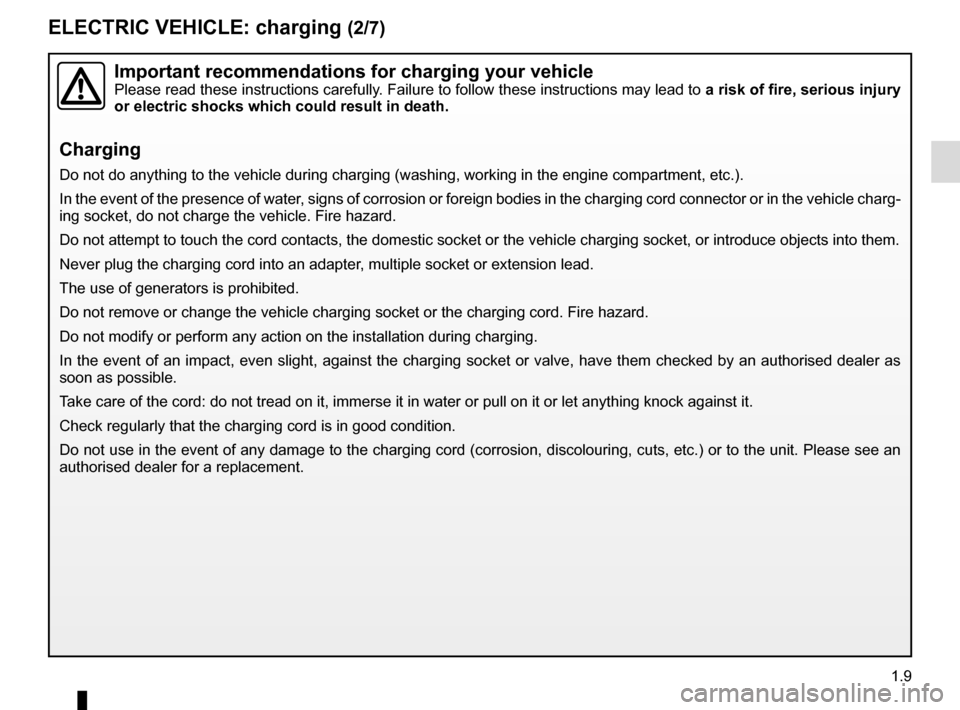
1.9
ELECTRIC VEHICLE: charging (2/7)
Important recommendations for charging your vehiclePlease read these instructions carefully. Failure to follow these instructions may lead to a risk of fire, serious injury
or electric shocks which could result in death.
Charging
Do not do anything to the vehicle during charging (washing, working in \
the engine compartment, etc.).
In the event of the presence of water, signs of corrosion or foreign bodies in the charging cord connector or\
in the vehicle ch arg-
ing socket, do not charge the vehicle. Fire hazard.
Do not attempt to touch the cord contacts, the domestic socket or the ve\
hicle charging socket, or introduce objects into them.
Never plug the charging cord into an adapter, multiple socket or extension lead.
The use of generators is prohibited.
Do not remove or change the vehicle charging socket or the charging cord\
. Fire hazard.
Do not modify or perform any action on the installation during charging.\
In the event of an impact, even slight, against the charging socket or v\
alve, have them checked by an authorised dealer as
soon as possible.
Take care of the cord: do not tread on it, immerse it in water or pull on\
it or let anything knock against it.
Check regularly that the charging cord is in good condition.
Do not use in the event of any damage to the charging cord (corrosion, \
discolouring, cuts, etc.) or to the unit. Please see an
authorised dealer for a replacement.
Page 16 of 220

1.10
ELECTRIC VEHICLE: charging (3/7)
Charging cord A
This cord, designed for specific wall
sockets or public terminals, enables the
standard charge of the traction battery.
A
Always read the charging cord instruc-
tions carefully before using it B.
B
Charging cord B
This cord allows:
– standard charge, on a socket used
only for the vehicle (14A charge);
– occasional charge using a domestic socket, when you are not at home,
for example (10A charge).
Sockets must be fitted as stated in the
instructions in the instructions supplied
with the charging cord B.
C
If a charging cord malfunctions
during the charging process (red
warning light on the unit D), stop
charging immediately. Please refer
to the cord instructions.
We recommend that you use a
charging cord that enables a stand-
ard charge to charge the traction
battery.
Each charging cord is stored in a
bag in the boot of the vehicle.
Never leave the socket hanging by
the cord. Use the hooks C to attach
it.
B
D
Page 17 of 220
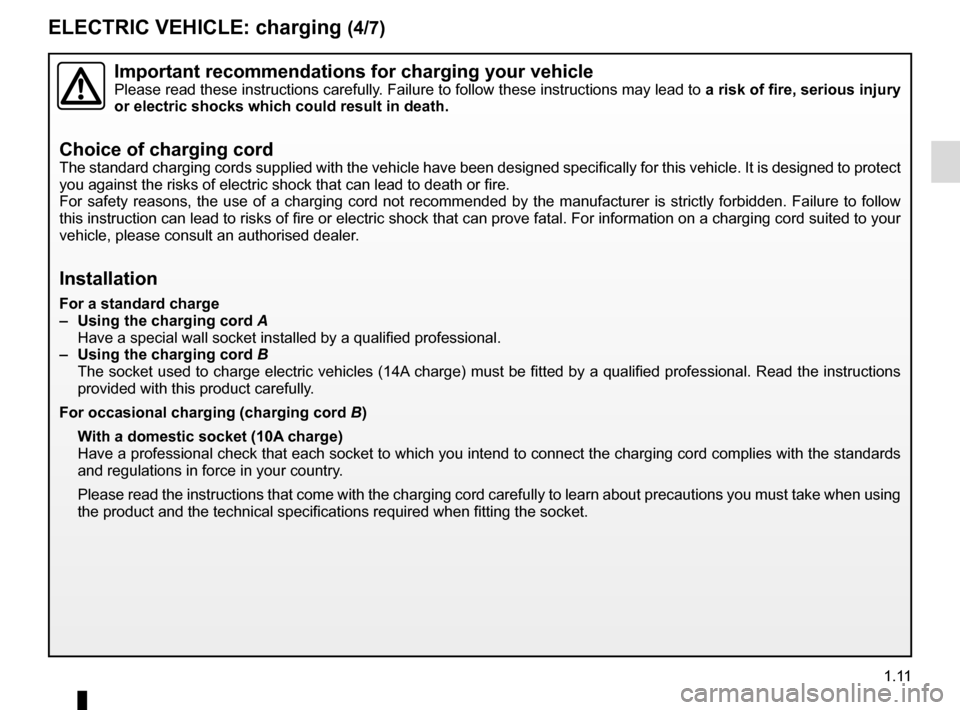
1.11
ELECTRIC VEHICLE: charging (4/7)
Important recommendations for charging your vehiclePlease read these instructions carefully. Failure to follow these instructions may lead to a risk of fire, serious injury
or electric shocks which could result in death.
Choice of charging cord
The standard charging cords supplied with the vehicle have been designed\
specifically for this vehicle. It is designed to prote ct
you against the risks of electric shock that can lead to death or fire.
For safety reasons, the use of a charging cord not recommended by the ma\
nufacturer is strictly forbidden. Failure to follow
this instruction can lead to risks of fire or electric shock that can pr\
ove fatal. For information on a charging cord suited to your
vehicle, please consult an authorised dealer.
Installation
For a standard charge
– Using the charging cord A
Have a special wall socket installed by a qualified professional.
– Using the charging cord B
The socket used to charge electric vehicles (14A charge) must be fitted by a qualified professional. Read the instructi\
ons provided with this product carefully.
For occasional charging (charging cord B)
With a domestic socket (10A charge)
Have a professional check that each socket to which you intend to connec\
t the charging cord complies with the standards
and regulations in force in your country.
Please read the instructions that come with the charging cord carefully \
to learn about precautions you must take when using the product and the technical specifications required when fitting the s\
ocket.
Page 18 of 220
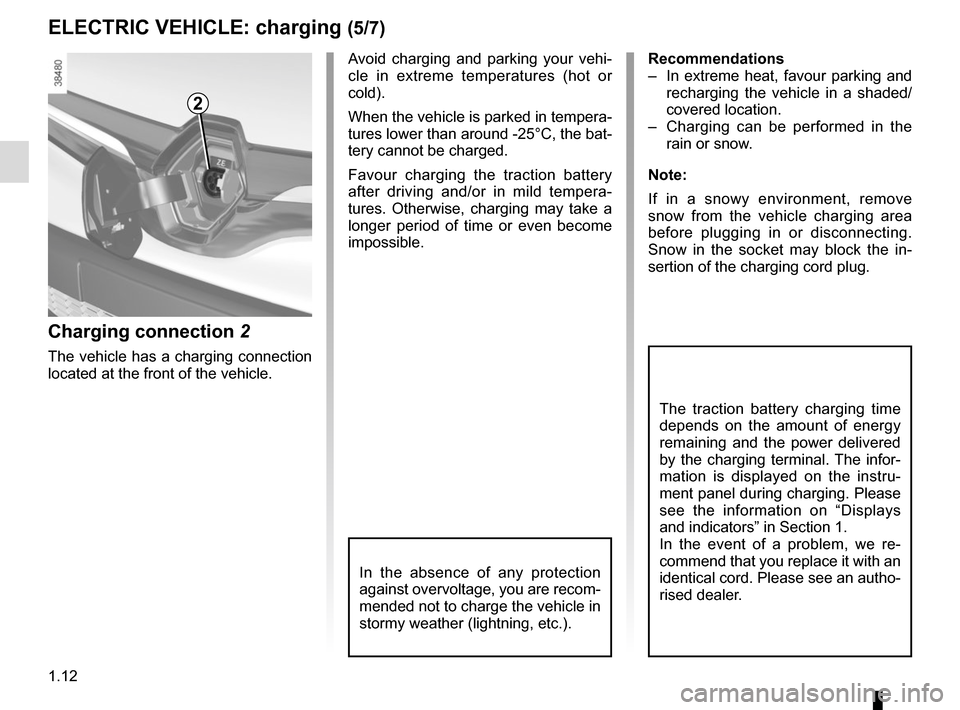
1.12
ELECTRIC VEHICLE: charging (5/7)
Charging connection 2
The vehicle has a charging connection
located at the front of the vehicle. Avoid charging and parking your vehi-
cle in extreme temperatures (hot or
cold).
When the vehicle is parked in tempera-
tures lower than around -25°C, the bat-
tery cannot be charged.
Favour charging the traction battery
after driving and/or in mild tempera-
tures. Otherwise, charging may take a
longer period of time or even become
impossible.
2
In the absence of any protection
against overvoltage, you are recom-
mended not to charge the vehicle in
stormy weather (lightning, etc.).
Recommendations
– In extreme heat, favour parking and
recharging the vehicle in a shaded/
covered location.
– Charging can be performed in the rain or snow.
Note:
If in a snowy environment, remove
snow from the vehicle charging area
before plugging in or disconnecting.
Snow in the socket may block the in-
sertion of the charging cord plug.
The traction battery charging time
depends on the amount of energy
remaining and the power delivered
by the charging terminal. The infor-
mation is displayed on the instru-
ment panel during charging. Please
see the information on “Displays
and indicators” in Section 1.
In the event of a problem, we re-
commend that you replace it with an
identical cord. Please see an autho-
rised dealer.